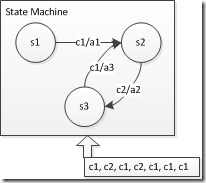转自:http://www.cnblogs.com/autosar/archive/2012/06/22/2558604.html
状态机模式是一种行为模式,在《设计模式》这本书中对其有详细的描述,通过多态实现不同状态的调转行为的确是一种很好的方法,只可惜在嵌入式环境下,有时只能写纯C代码,并且还需要考虑代码的重入和多任务请求跳转等情形,因此实现起来着实需要一番考虑。
近日在看了一个开源系统时,看到了一个状态机的实现,也学着写了一个,与大家分享。
首先,分析一下一个普通的状态机究竟要实现哪些内容。
状态机存储从开始时刻到现在的变化,并根据当前输入,决定下一个状态。这意味着,状态机要存储状态、获得输入(我们把它叫做跳转条件)、做出响应。
如上图所示,{s1, s2, s3}均为状态,箭头c1/a1表示在s1状态、输入为c1时,跳转到s2,并进行a1操作。
最下方为一组输入,状态机应做出如下反应:
| 当前状态 | 输入 | 下一个状态 | 动作 |
| s1 | c1 | s2 | a1 |
| s2 | c2 | s3 | a2 |
| s3 | c1 | s2 | a3 |
| s2 | c2 | s3 | a2 |
| s3 | c1 | s2 | a3 |
| s2 | c1 | s_trap | a_trap |
| s_trap | c1 | s_trap | a_trap |
当某个状态遇到不能识别的输入时,就默认进入陷阱状态,在陷阱状态中,不论遇到怎样的输入都不能跳出。
为了表达上面这个自动机,我们定义它们的状态和输入类型:
1 typedef int State; 2 typedef int Condition; 3 4 #define STATES 3 + 1 5 #define STATE_1 0 6 #define STATE_2 1 7 #define STATE_3 2 8 #define STATE_TRAP 3 9 10 #define CONDITIONS 2 11 #define CONDITION_1 0 12 #define CONDITION_2 1
在嵌入式环境中,由于存储空间比较小,因此把它们全部定义成宏。此外,为了降低执行时间的不确定性,我们使用O(1)的跳转表来模拟状态的跳转。
首先定义跳转类型:
1 typedef void (*ActionType)(State state, Condition condition); 2 3 typedef struct 4 { 5 State next; 6 ActionType action; 7 } Trasition, * pTrasition;
然后按照上图中的跳转关系,把三个跳转加一个陷阱跳转先定义出来:
1 // (s1, c1, s2, a1) 2 Trasition t1 = { 3 STATE_2, 4 action_1 5 }; 6 7 // (s2, c2, s3, a2) 8 Trasition t2 = { 9 STATE_3, 10 action_2 11 }; 12 13 // (s3, c1, s2, a3) 14 Trasition t3 = { 15 STATE_2, 16 action_3 17 }; 18 19 // (s, c, trap, a1) 20 Trasition tt = { 21 STATE_TRAP, 22 action_trap 23 };
其中的动作,由用户自己完成,在这里仅定义一条输出语句。
1 void action_1(State state, Condition condition) 2 { 3 printf("Action 1 triggered. "); 4 }
最后定义跳转表:
1 pTrasition transition_table[STATES][CONDITIONS] = { 2 /* c1, c2*/ 3 /* s1 */&t1, &tt, 4 /* s2 */&tt, &t2, 5 /* s3 */&t3, &tt, 6 /* st */&tt, &tt, 7 };
即可表达上文中的跳转关系。
最后定义状态机,如果不考虑多任务请求,那么状态机仅需要存储当前状态便行了。例如:
1 typedef struct 2 { 3 State current; 4 } StateMachine, * pStateMachine; 5 6 State step(pStateMachine machine, Condition condition) 7 { 8 pTrasition t = transition_table[machine->current][condition]; 9 (*(t->action))(machine->current, condition); 10 machine->current = t->next; 11 return machine->current; 12 }
但是考虑到当一个跳转正在进行的时候,同时又有其他任务请求跳转,则会出现数据不一致的问题。
举个例子:task1(s1, c1/a1 –> s2)和task2(s2, c2/a2 –> s3)先后执行,是可以顺利到达s3状态的,但若操作a1运行的时候,执行权限被task2抢占,则task2此时看到的当前状态还是s1,s1遇到c2就进入陷阱状态,而不会到达s3了,也就是说,状态的跳转发生了不确定,这是不能容忍的。
因此要重新设计状态机,增加一个“事务中”条件和一个用于存储输入的条件队列。修改后的代码如下:
1 #define E_OK 0 2 #define E_NO_DATA 1 3 #define E_OVERFLOW 2 4 5 typedef struct 6 { 7 Condition queue[QMAX]; 8 int head; 9 int tail; 10 bool overflow; 11 } ConditionQueue, * pConditionQueue; 12 13 14 int push(ConditionQueue * queue, Condition c) 15 { 16 unsigned int flags; 17 Irq_Save(flags); 18 if ((queue->head == queue->tail + 1) || ((queue->head == 0) && (queue->tail == 0))) 19 { 20 queue->overflow = true; 21 Irq_Restore(flags); 22 return E_OVERFLOW; 23 } 24 else 25 { 26 queue->queue[queue->tail] = c; 27 queue->tail = (queue->tail + 1) % QMAX; 28 Irq_Restore(flags); 29 } 30 return E_OK; 31 } 32 33 int poll(ConditionQueue * queue, Condition * c) 34 { 35 unsigned int flags; 36 Irq_Save(flags); 37 if (queue->head == queue->tail) 38 { 39 Irq_Restore(flags); 40 return E_NO_DATA; 41 } 42 else 43 { 44 *c = queue->queue[queue->head]; 45 queue->overflow = false; 46 queue->head = (queue->head + 1) % QMAX; 47 Irq_Restore(flags); 48 } 49 return E_OK; 50 } 51 52 typedef struct 53 { 54 State current; 55 bool inTransaction; 56 ConditionQueue queue; 57 } StateMachine, * pStateMachine; 58 59 static State __step(pStateMachine machine, Condition condition) 60 { 61 State current = machine -> current; 62 pTrasition t = transition_table[current][condition]; 63 (*(t->action))(current, condition); 64 current = t->next; 65 machine->current = current; 66 return current; 67 } 68 69 State step(pStateMachine machine, Condition condition) 70 { 71 Condition next_condition; 72 int status; 73 State current; 74 if (machine->inTransaction) 75 { 76 push(&(machine->queue), condition); 77 return STATE_INTRANSACTION; 78 } 79 else 80 { 81 machine->inTransaction = true; 82 current = __step(machine, condition); 83 status = poll(&(machine->queue), &next_condition); 84 while(status == E_OK) 85 { 86 __step(machine, next_condition); 87 status = poll(&(machine->queue), &next_condition); 88 } 89 machine->inTransaction = false; 90 return current; 91 } 92 } 93 94 void initialize(pStateMachine machine, State s) 95 { 96 machine->current = s; 97 machine->inTransaction = false; 98 machine->queue.head = 0; 99 machine->queue.tail = 0; 100 machine->queue.overflow = false; 101 }
